
Around San Marco

 |
Around San Marco |
 |
| Home |
Dorsoduro | Picture of the Week |
| Cannaregio |
San Polo | External Links |
| Castello | Santa Croce |
My favorites |

| It
is hard to think of any hidden corners in the most visited district of
Venice, San Marco, where
thousands of
tourists get lost every day, but some of San Marco's most interesting
treasures are hidden in plain sight. Take for example the curious
inhabitants on top of the two columns by the waterfront, in an area
called the Molo, near the
Doge's Palace: A
winged lion, a soldier and a dragon. The winged lion is the symbol of
Saint Mark, the patron saint of Venice. The soldier is Saint Theodore
(San Todaro),
a Greek general who used to be Venice's patron saint until demoted upon
the arrival of the stolen body of the mightier San Marco, an
evangelist, no less. The dragon under
Saint Theodore's feet is a later addition of unclear origin. The lion,
the dragon and the soldier bore witness to
hundreds of executions carried out by the state. Criminals, murderers,
traitors and even homosexuals were hanged, decapitated or burned alive
between the two columns. And in so doing, Venice showed her egalitarian
side, albeit in its most macabre angle. The two
columns, where so many
unfortunate souls took their last breaths, were also the ceremonial
gate to Venice, the welcoming
entrance to kings and princes. Walking between the columns
is considered bad luck, and superstitious Venetians avoid it even
today. |
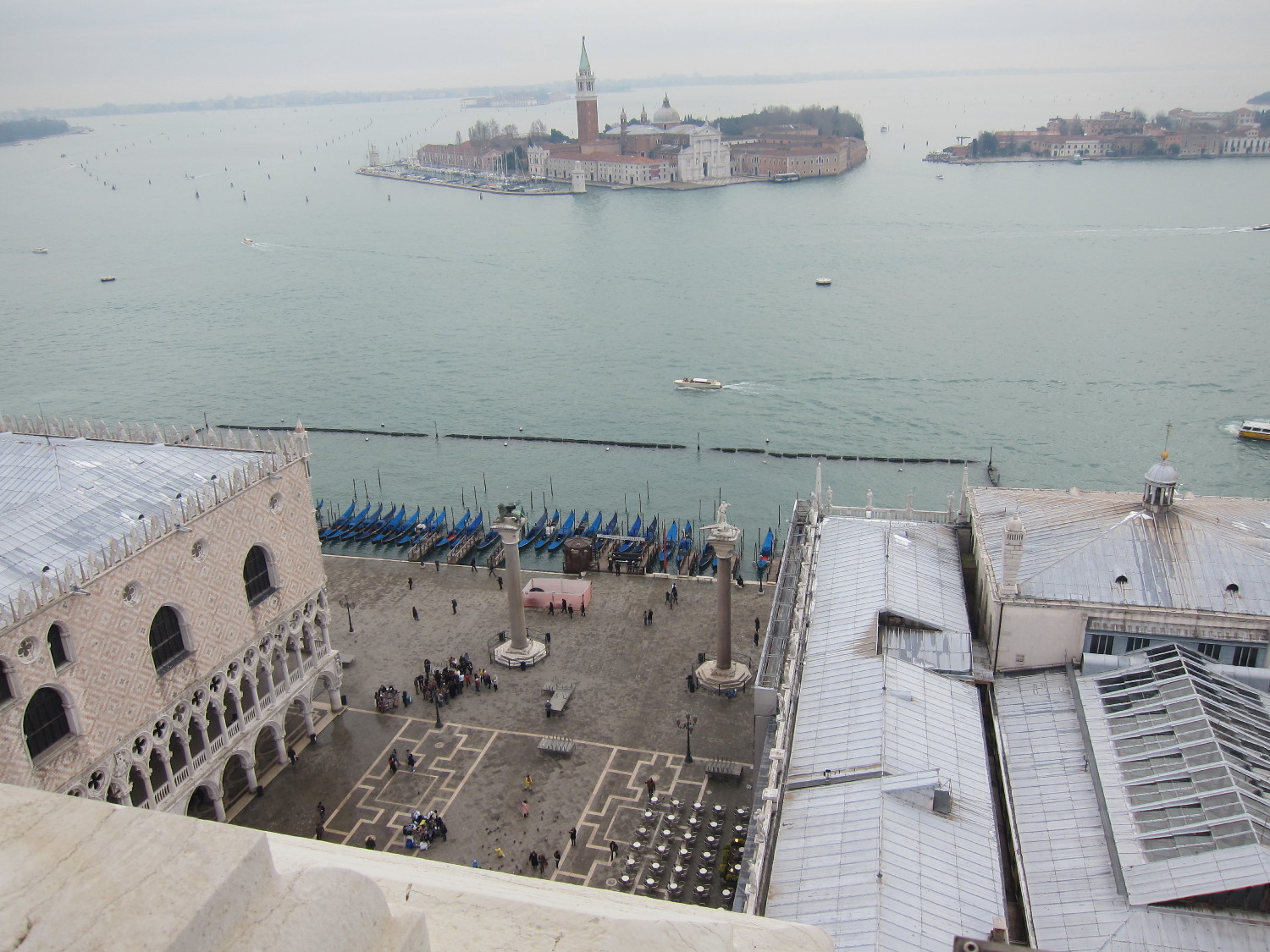 |
 |
 |
| The
statue of Saint Theodore is a pastiche: The head is a portrait of king
Mithridates, from Pontus; the body is that of a Roman soldier and dates
from Hadrian's times. The dragon dates from the 15th century. The
original sculpture is kept in the Doge's Palace; what we see on top of
the column today is a reproduction. The lion didn't fare much better.
While
its origin is debated –it's believed to be either Etruscan or Persian
or even Chinese– the book and the wings were added later to make it a
true lion of Saint Mark. It was taken to Paris by Napoleon's army in
1797, at the fall of the Venetian Republic, and brought back in pieces
in 1815. It was once covered in gold. The granite columns on which they
stand were brought from Syria in 1172. Venetians didn't know how to set
them up until Nicolò Barattieri, a Lombard engineer, took up
the
challenge in 1180, in exchange for the rights to set up a gambling
table between the two columns. |
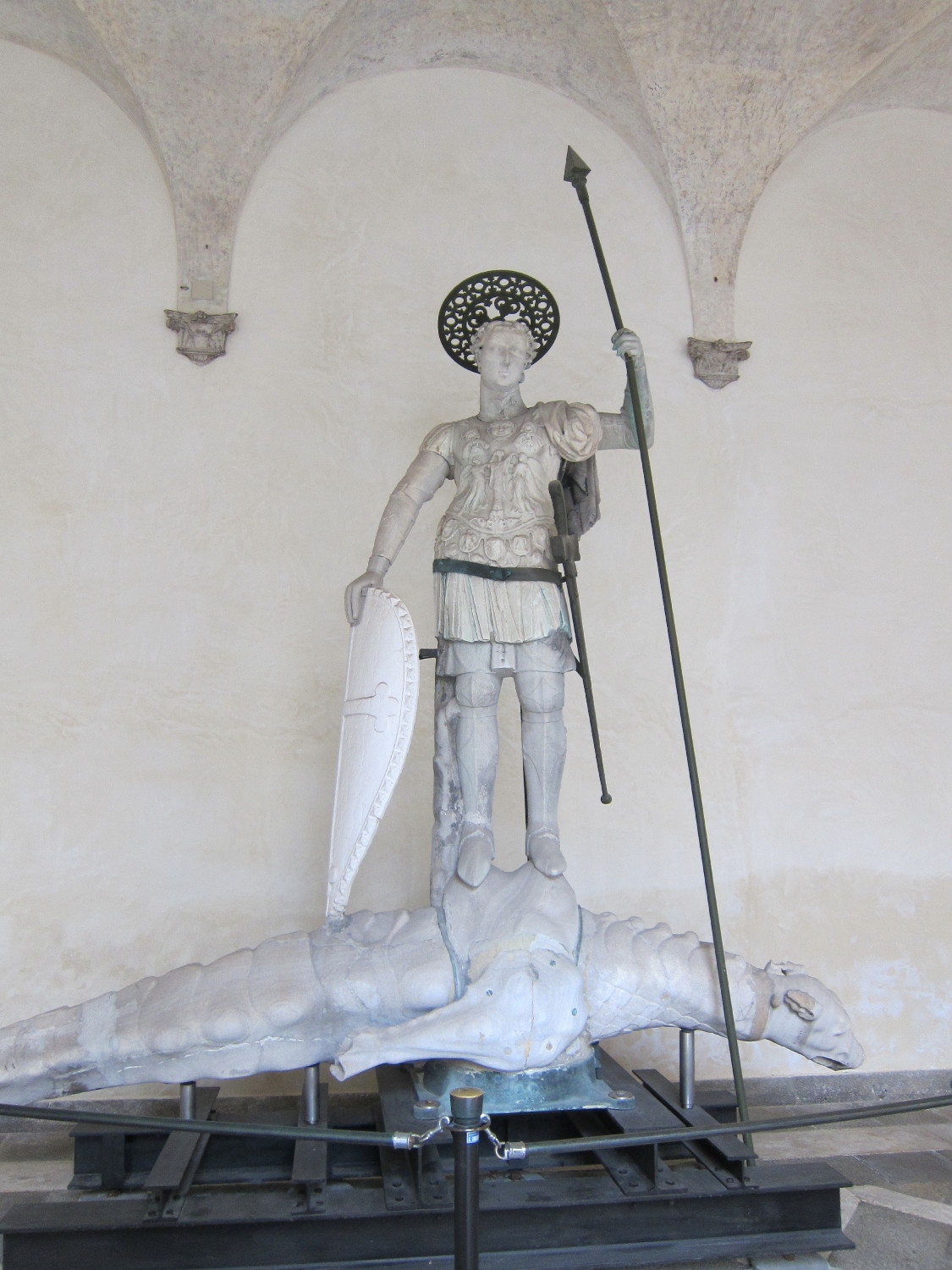 Original San Todaro at the Doge's Palace |
| Map
of Venice |
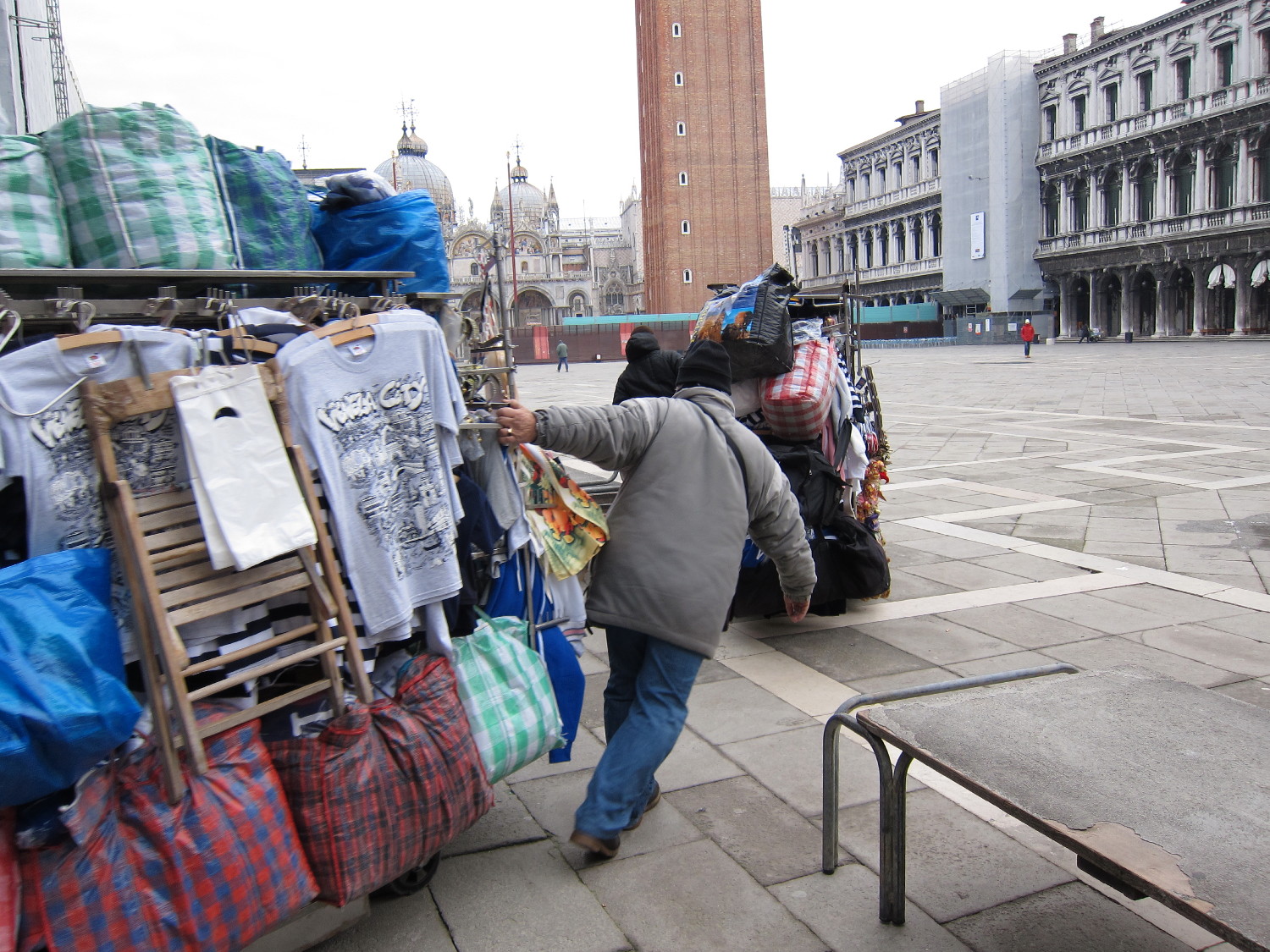 |
 |
A
few meters away from the Molo,
under the arches of the Procuratie
Nove, is Caffè
Florian, one of the first coffeehouses in Italy and in operation
since
1720. Its first owner, Floriano Francesconi, called it Alla Venezia Triomfante. A detour
at Florian is a must; you
will be sitting in the same plush rooms where once the likes of Verdi,
Proust and Casanova mingled. However, a look behind the scenes could
also be rewarding. In the back of the Procuratie
Nove is a series of courtyards, seven to be precise, with a
treasure trove of sculptures, magnificent wellheads (vere da pozzo) and other
architectural details haphazardly scattered. Some of these vere da pozzo are very old,
displaying protochristian motifs. And trust me, you will find no
tourists there. 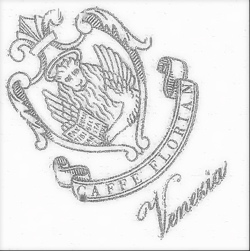 |
 |
 |
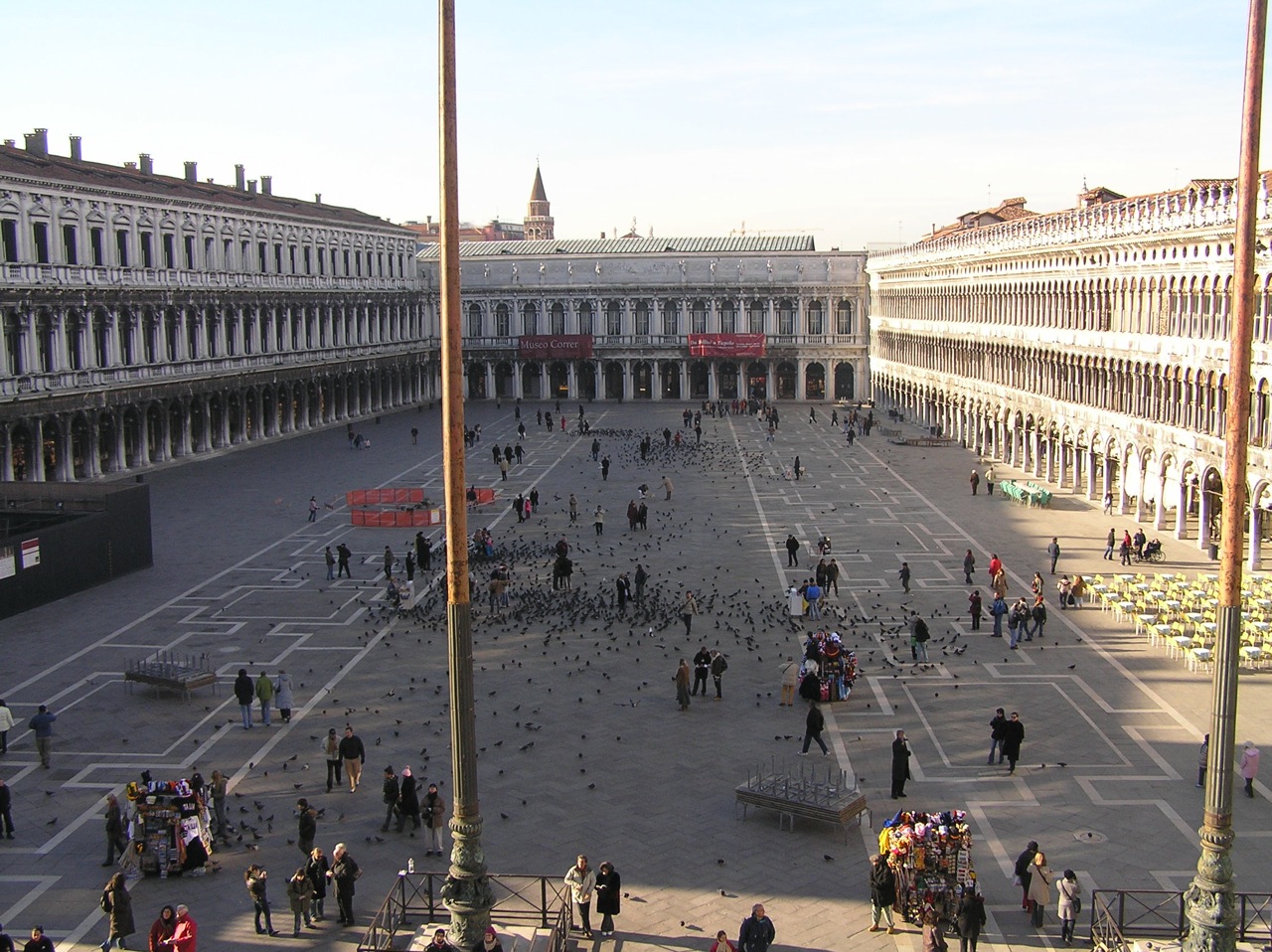
| Before
you exit the Piazza you may want to visit one of Venice's most
interesting museums: Museo Correr.
The entrance to the museum is under the arches of the Ala Napoleonica, on the western
side of the Piazza. A tour of its halls will give you a panoramic view
of Venice's history, architecture, art, social life and naval power
in centuries past. The unique and marvelous woodcut of Venice by Jacopo
de' Barbari (from 1500) is on display here along with works by Canova,
Carpaccio and Bellini. |
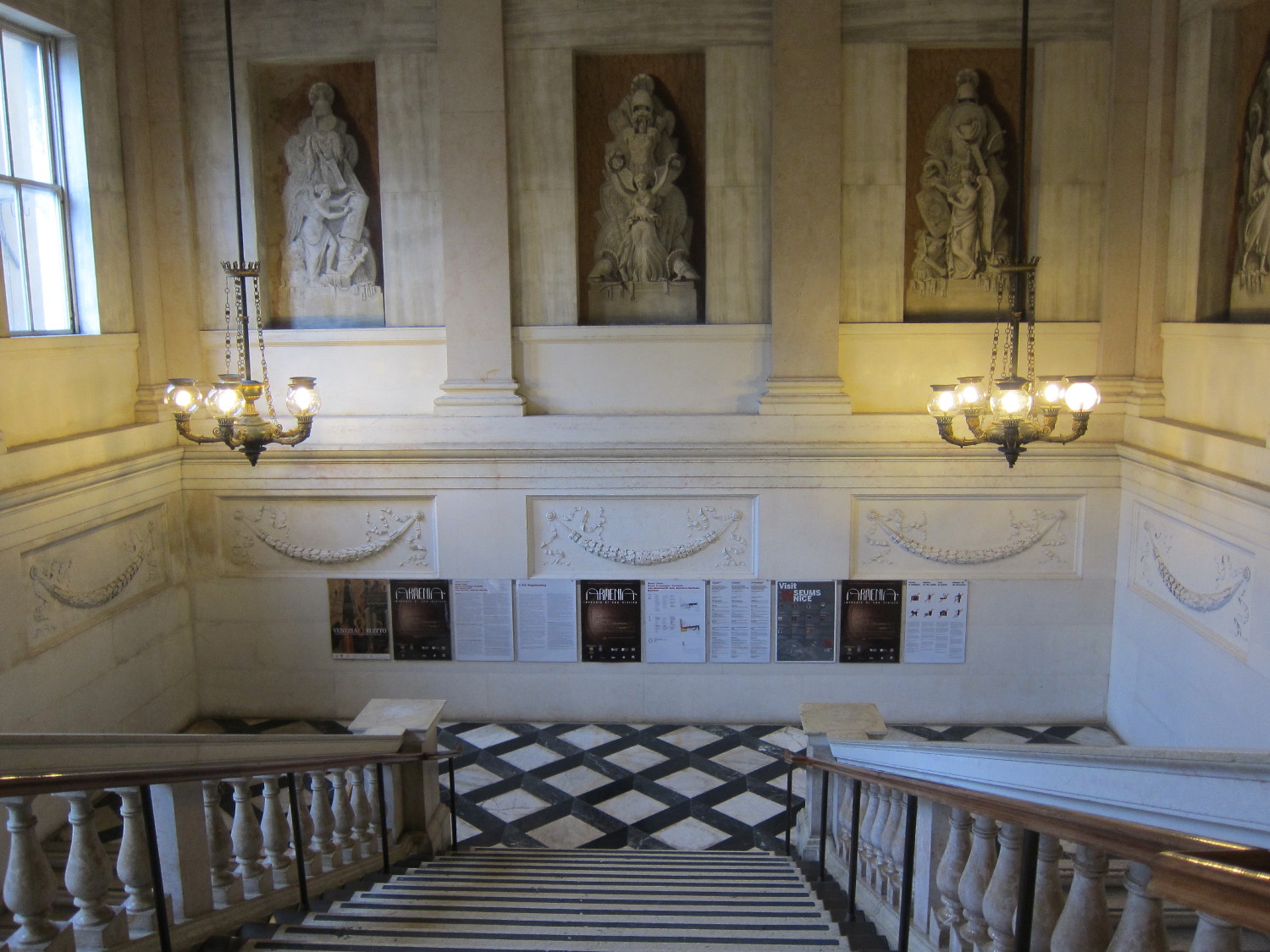 |
If
you exit the Piazza at the end of the Procuratie Nove you will be on
Calle Seconda de l'Ascension. If you turn left on Calle Vallaresso (the
first intersection), at the end of it on your left you will see Harry's
Bar. Made
famous by Hemingway and Woody Allen and patronized by "anybody who
wants
to
be somebody." Harry's
Bar is the birthplace of the Bellini
cocktail (white peach puree
and prosecco) and the Carpaccio
meat dish (thinly sliced raw beef with mustard sauce).  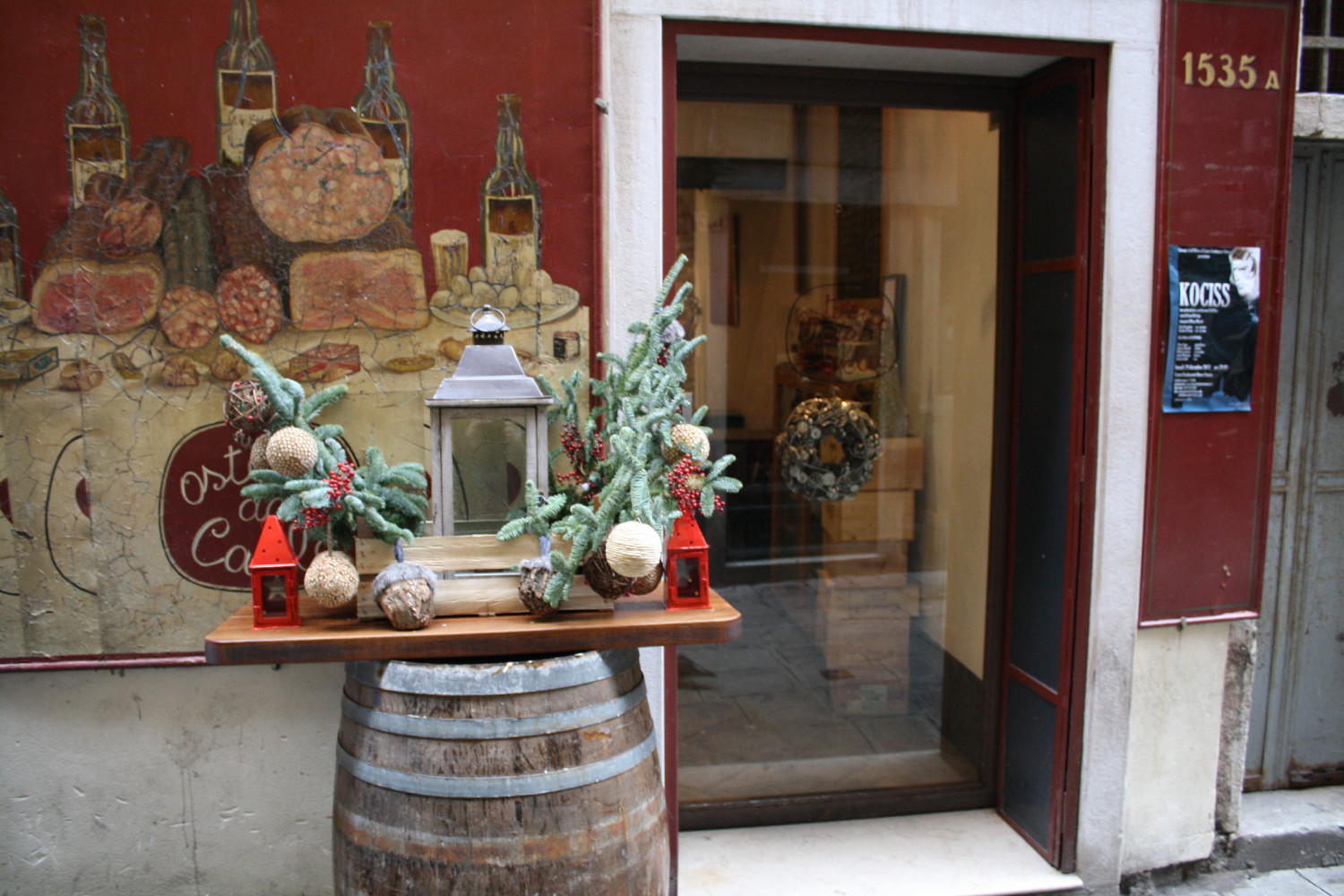 Go back to Calle Seconda de l'Ascension and soon you will be on Salizada San Moisè that leads to Campo San Moisè. The Baroque façade of the church consecrated to the Jewish saint is the work of Alessandro Tremignon and Heinrich Meyring (17th century). Cross Ponte San Moisè and you will reach one of the most elegant commercial streets in Venice, Calle Larga XXII Marzo, lined with fashionable boutiques and posh hotels and restaurants. |
 |
 |
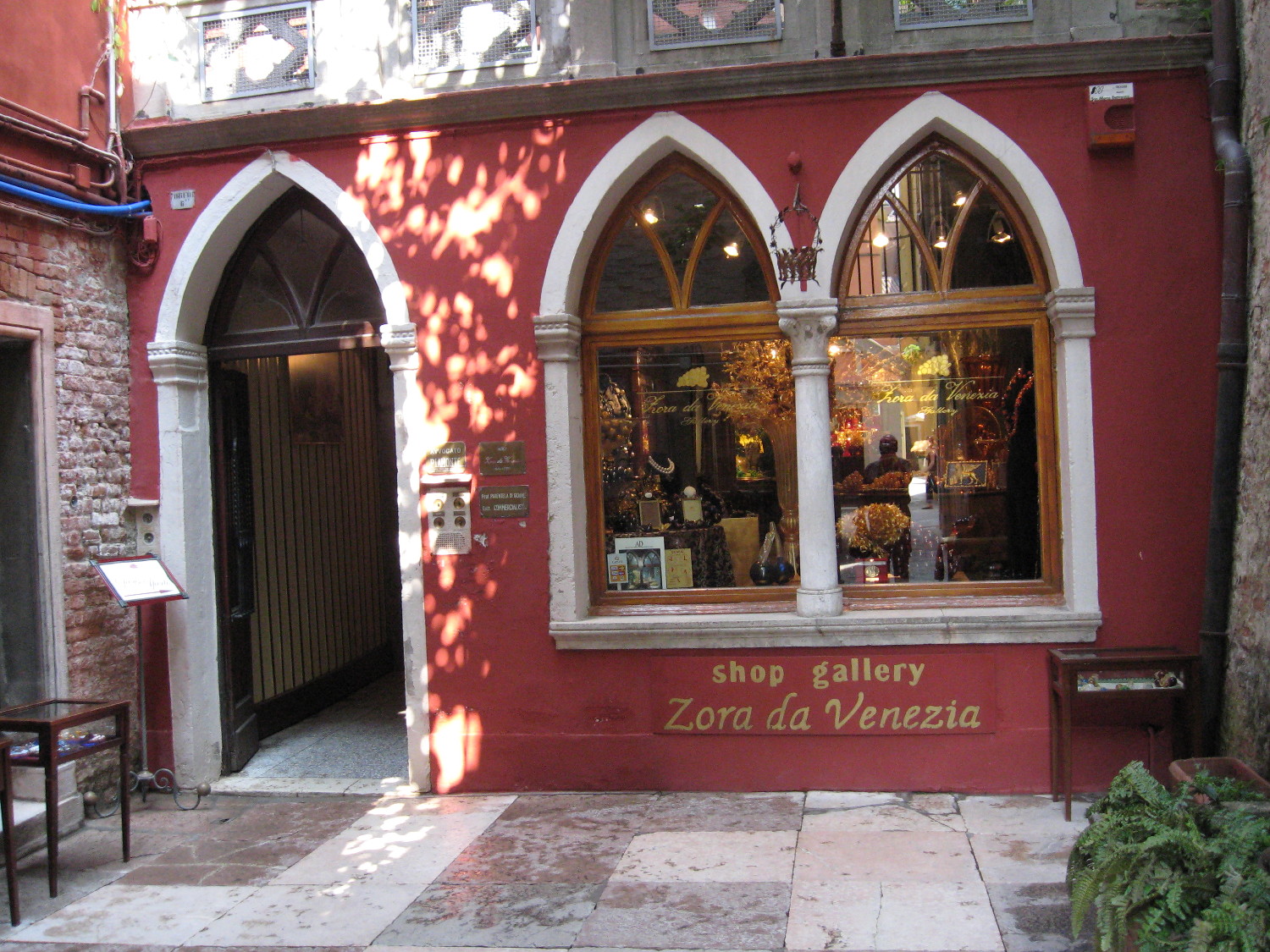 |
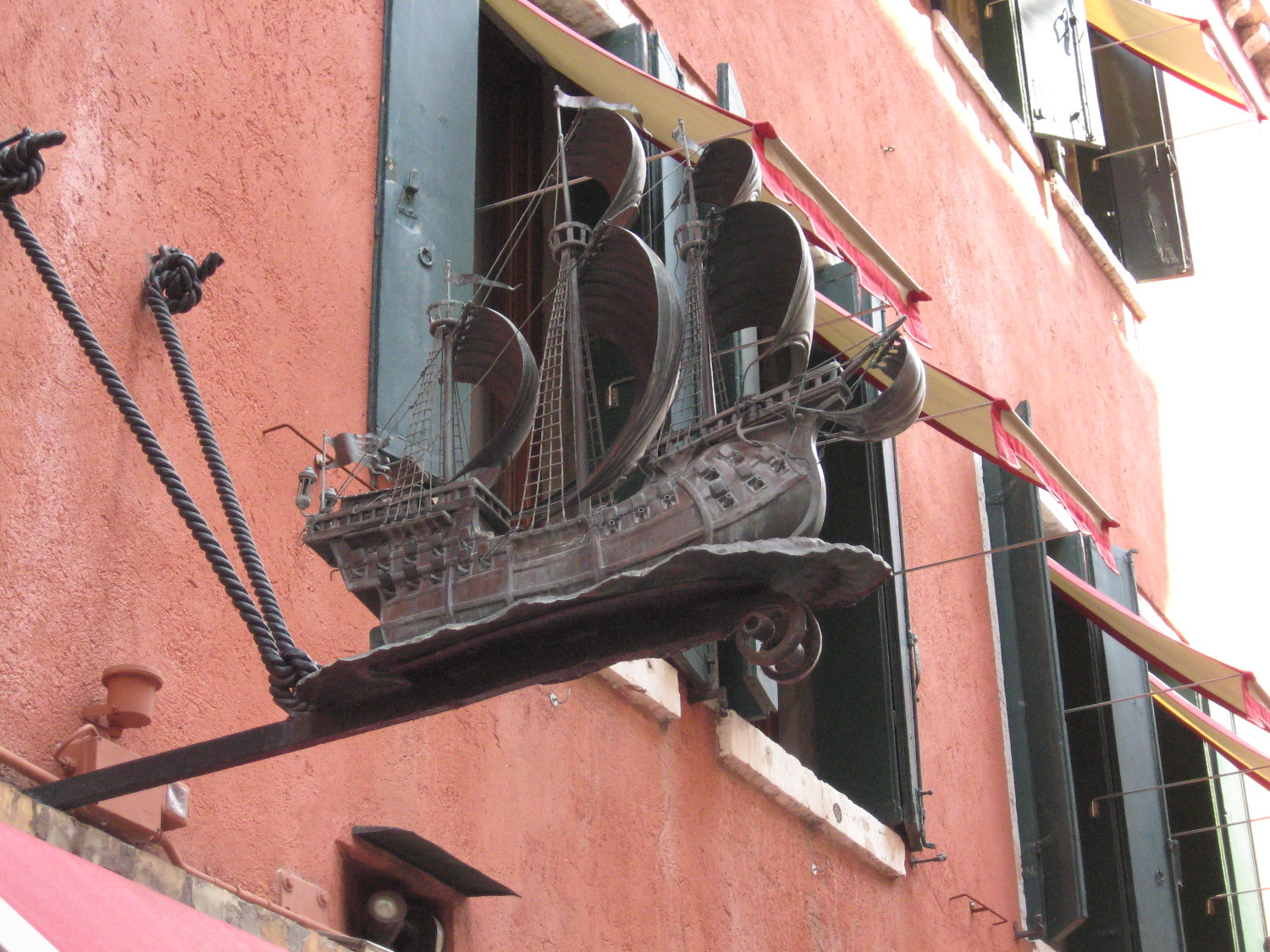 |
| At Ponte San Moisè there is an important gondola station on one side and the rather nondescript entrance to the five-star-plus Bauer Hotel on the other. |

| As
you continue on Calle Larga XXII Marzo, if you turn left on Calle del
Squero you will soon reach Corte Barozzi, a hidden place with a
beautiful vera da pozzo in
Istrian stone from the 17th century and the entrance to the Hotel Europa & Regina.
From
this corte take Calle Barozzi to its end on Calle
del Tragheto. To the right is Corte San Moisè. A vera da pozzo in pink Verona marble
is in the center and a plaque on an adjacent building tells us that in
the Teatro Minerva or San Moisè on July 9, 1896,
the first Venetian projection of the Lumière Brothers' cinématograph took place.
This was only six
months after the very first projection in Paris. From the end of Calle
del Tragheto you have an outstanding view of the church of La Salute, across the Grand Canal. |
 Corte Barozzi |
 Corte Barozzi |
 Corte San Moisè |
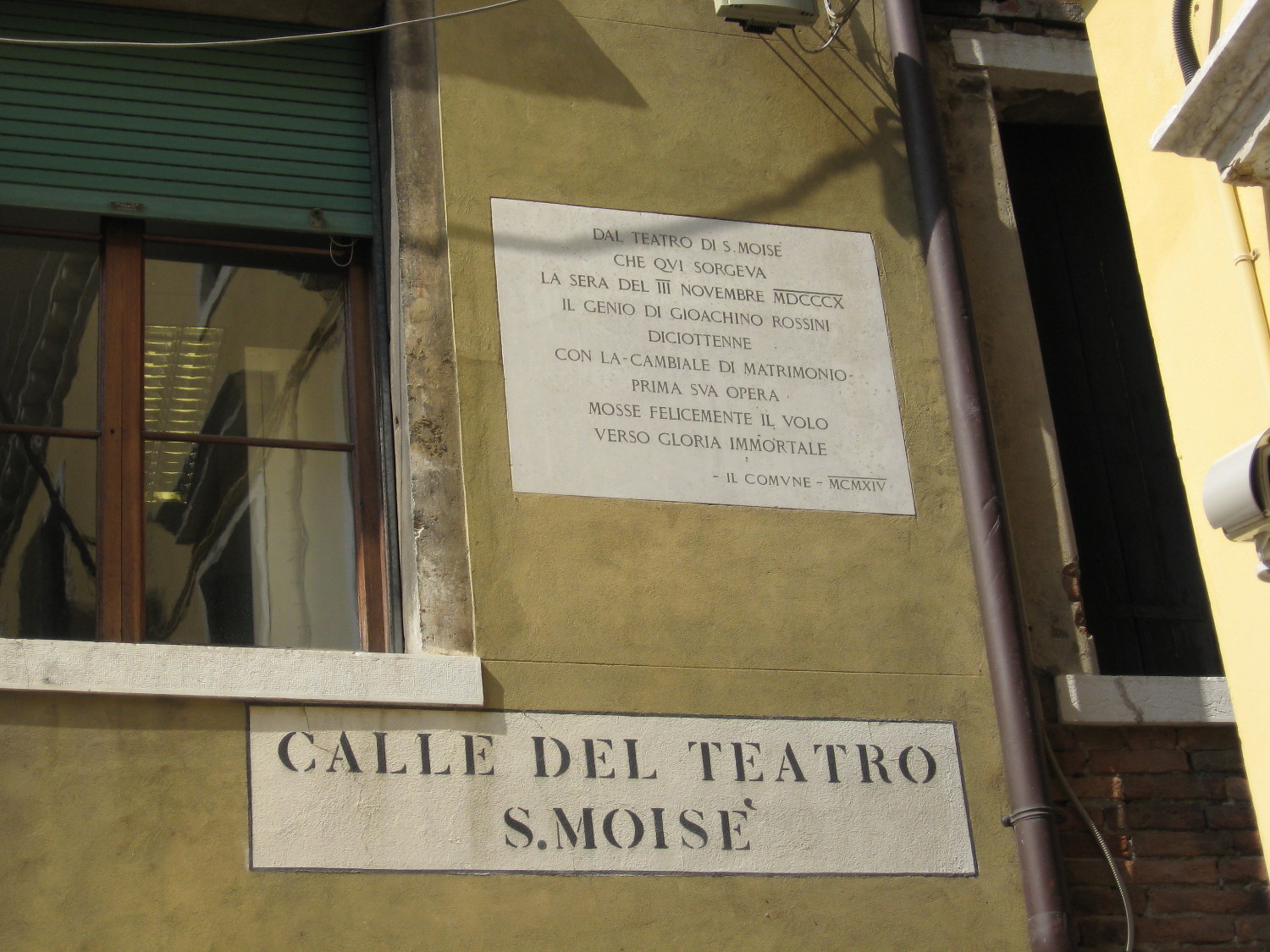 Calle San Moisè |

| Go back to Calle XXII Marzo. As the street narrows and turns left it becomes Calle de le Ostreghe (Street of the Oysters). If you lift your eyes, you will see a set of beautiful windows in the Venetian Gothic style that belong to Hotel Torino. As you cross Rio de l'Alboro you'll see to your left the perfectly located Ristorante da Raffaele and a charming wrought-iron bridge with the backdrop of Palazzo Genovese, a modern construction in Neogothic style, on the other side of the Grand Canal. Right behind you is La Ricerca, one of the largest bookbinders in Venice. Etchings, bookmarks, and blank books can be found here. |

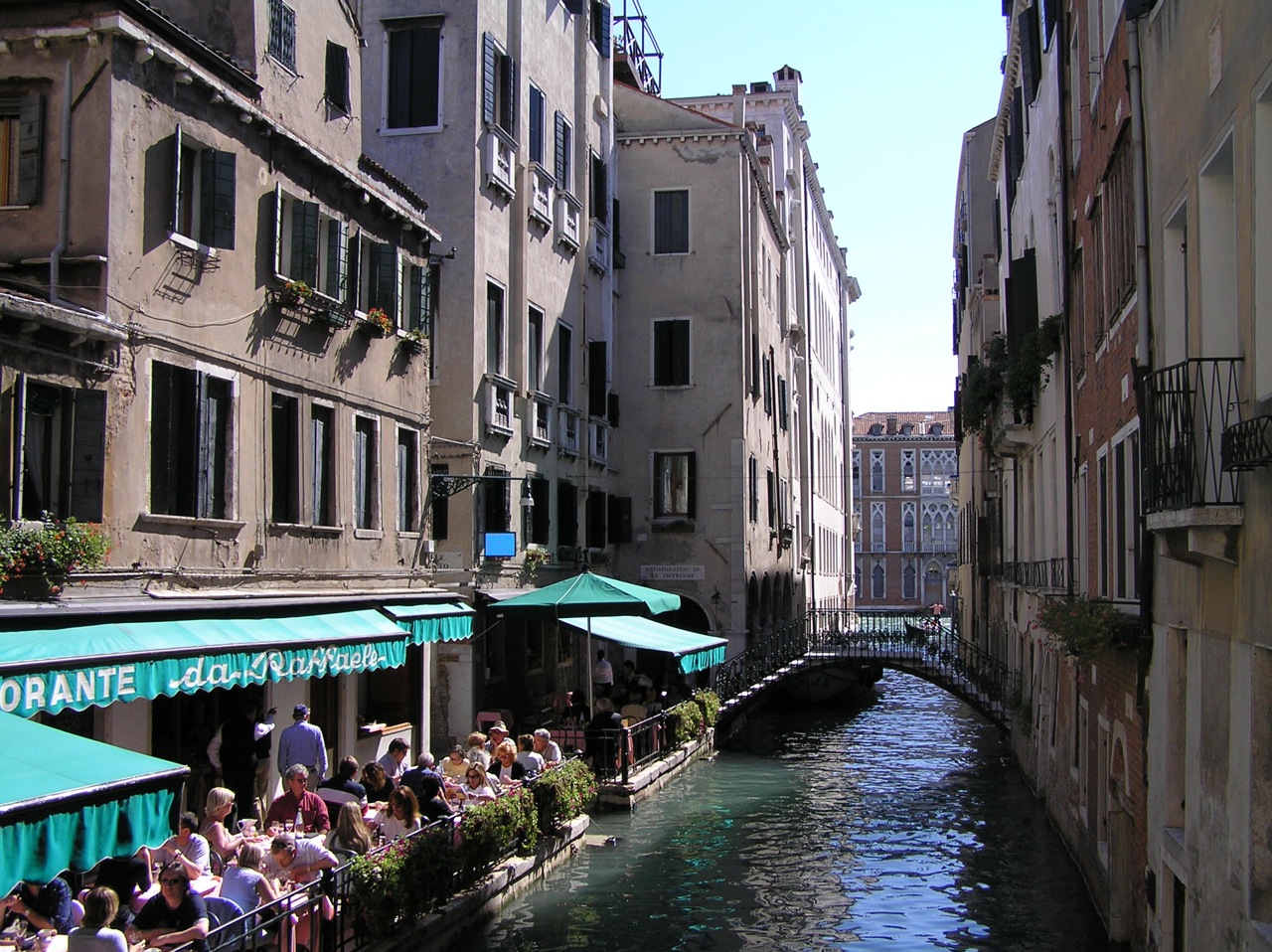 |
 |
| After you cross the bridge and before you reach the next campo, you will see on your left a very Venetian store, Il Prato. They specialize in blank books, paper-mache dolls, and amazing miniatures. As you continue in the same direction you will reach Campo Santa Maria Zobenigo or del Giglio. The church of the same name will be in front of you, to the right. Along with the church of San Moisè it has one of the most ornate façades in the city. The interior houses a treasure trove of relics, among them pieces of the robes of Saint Francis and Saint Catharine and bone fragments from Saint Claire and Saint Stephen. Just the Annunciation on both sides of the main altar, a work of Heinrich Meyring (17th century), makes this church worth the visit. |

 |
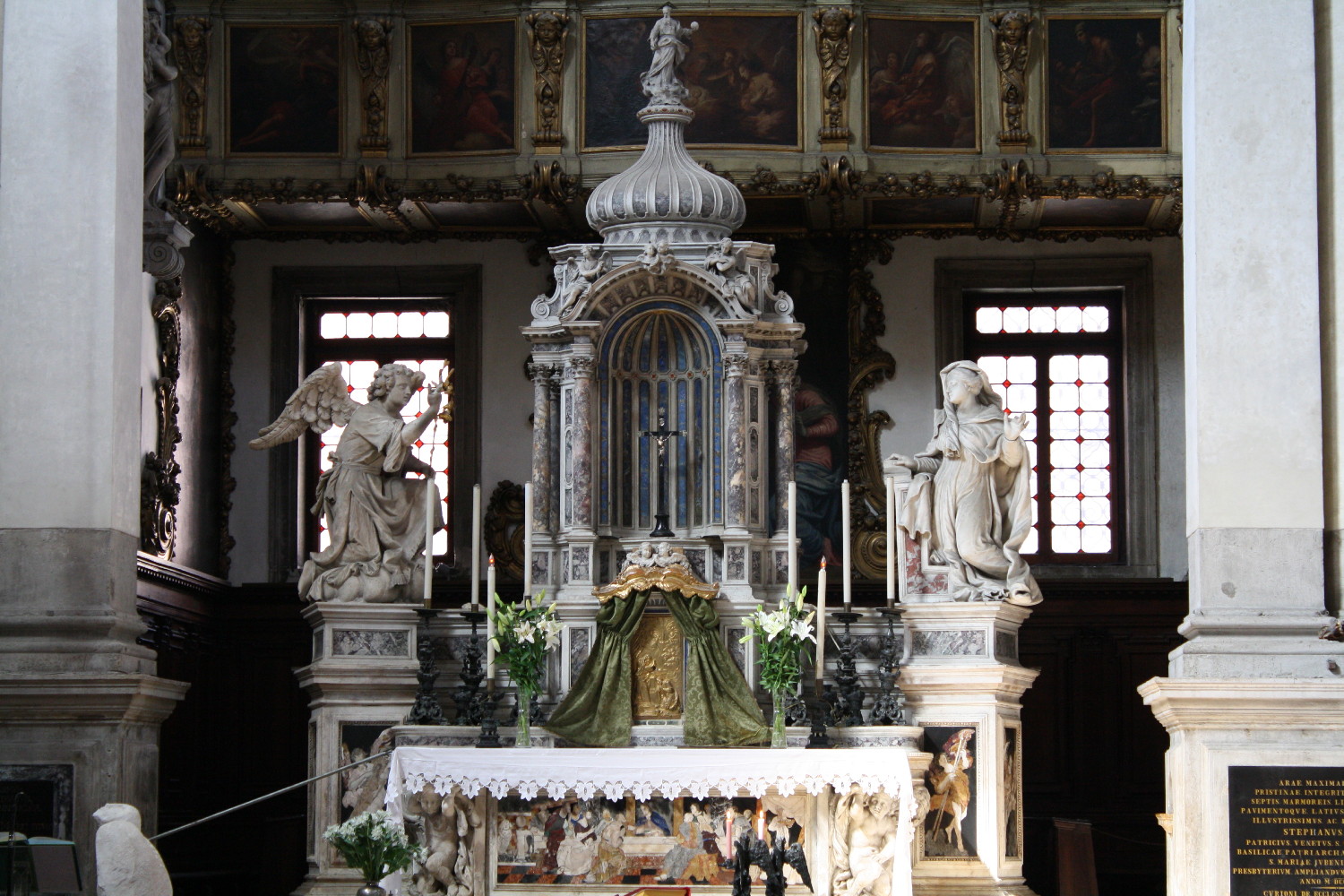 |
| As we leave Campo Santa Maria Zobenigo the truncated remains of the old bell tower now transformed into a gift shop will be on your left. Cross Ponte and Campiello de la Feltrina. Bar Tarnowska's will be on your left. Bar Tarnowska's is part of the Hotel Ala where at the turn of the 20th century the assassination of Maria Tarnowska's lover took place. Maria Tarnowska was an interesting character. Born in Ukraine in 1877 and married to Russian aristocracy, she became famous as the instigator of the murder of one of her lovers by another one of her lovers. Apparently, her beauty was devastating to the men who got involved with her. Two of them died and four abandoned their wives and children. She stood trial in 1910 and was found guilty. The trial was followed intensely by the public, who wanted to drown her, and by the newspapers on both sides of the Atlantic. She died in Argentina in 1949. |
 |
 Maria Tarnowska going to court Maria Tarnowska going to court |
 |
Cross
Rio San Maurizio at Ponte Zaguri and soon
you
will be in charming Campo San Maurizio. If you are lucky, you will be
there when they organize a wonderful antiques fair (Mercatino dell'Antiquariato)
usually held three times a year, for a three-day weekend,
at the beginning of April, in mid September and during the weekend
before Christmas. More than a hundred merchants offer any imaginable
trinket and more, from antique Burano lace to a pair of life-size
lions.  |
| At the church of San Maurizio there is always some interesting exhibition open to the public. Lately, it's been on musical instruments at the time of Vivaldi. Exit Campo San Maurizio through Calle del Piovan (Street of the Parish Priest), by the front of the church. At number 2762 is the former Scuola degli Albanesi. A relief above the door shows Sultan Mehmed II looking at the castle of Scutari (Albania) which fell to the Turks in 1479. Right below is a relief of the Madonna and Child. |
 |
| A few steps further down you will see one of the most original stores in Venice, Il Papiro, where you can find superb stationery, unique marbled paper, and leather-bound journals. It is a paradise for those who love to write by hand. After crossing the bridge (Ponte San Maurizio) you will see to your left on Calle del Spezier (Street of the Spice Merchant) an art gallery: Galleria Contini. Check it out; you may be amazed by the exhibit in the courtyard. It could be one of the stunning sculptures by Polish artist Igor Mitoraj or the work of some local genius. If you are not amazed, you can always take comfort in the wonderful local pastries at the store across the street or the unique gelato at Paolin on Campo Santo Stefano. |
 |
 |
 Artist: Igor Mitoraj |
 "Davide's Renaissance" Artist: Giuseppe Veneziano, 2011 |
| Calle
del Spezier ends at Campo Santo Stefano, also called Campo
Francesco Morosini. In the middle of the campo is the statue of
Nicolò
Tommaseo affectionately called by Venetians "el cagalibri" -the
book-pooper- for self-evident reasons. Tommaseo, along with Daniele
Manin, participated in the Venetian insurrection against the Austrian
rulers in 1848. He was one of the most important figures of the Italian
unification. Campo
Santo
Stefano is the place to watch Venetians (and tourists) go by, and the
best seats are in Gelateria
Paolin. This campo used to be transformed
in an
Alpine village at Christmastime when it hosted a great Christmas
market, but, sadly, the tradition was discontinued a few years
ago. Campo Santo Stefano and the adjoining areas
have still a lot to offer year round. Just walk around and you'll be
surprised. |
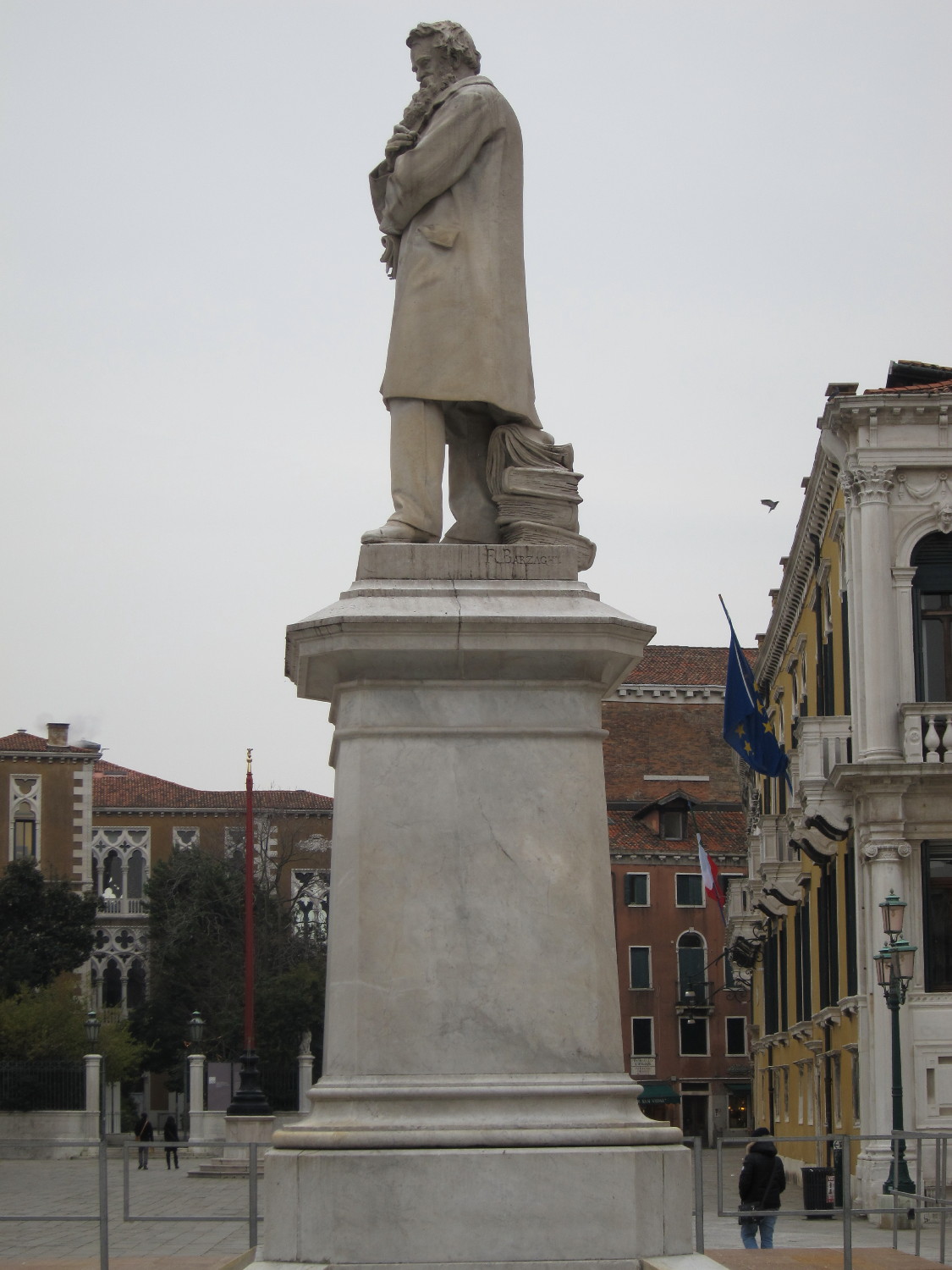 |
 Campiello Loredan |
There
are six other campi and campielli around Campo Santo
Stefano: Campiello
Santo Stefano where the main entrance to the Santo Stefano
church is
located; Campiello
Novo o dei Morti, a former cemetery in a secluded location
enclosing charming Locanda Fiorita; Campiello
Loredan, behind Palazzo Loredan and where you will find a
typical Venetian wood carving and gilding studio; Campo Pisani
that
also serves as an outdoor theater in the summer months; Campiello San
Vidal, where you can visit the former church of San Vidal, now a
concert hall and art gallery. One of the works on display is "San Vidal on Horseback" by Vittore
Carpaccio; and Campo
San Vidal that leads to Ponte de l'Accademia. 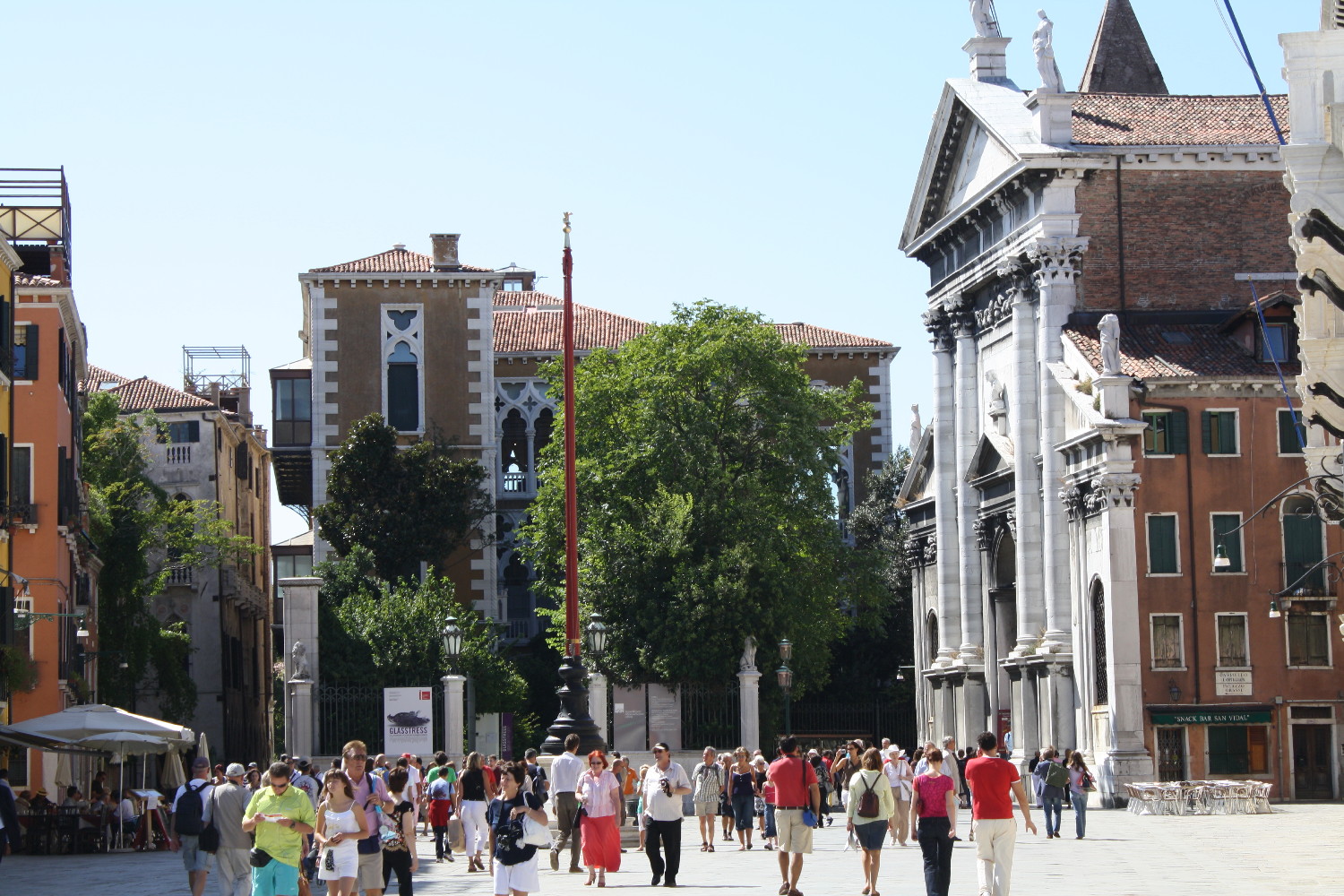 In the courtyard of Palazzo Morosini, that you can see from Calle Streta Morosini, there is a vera da pozzo very similar in shape to the one on Calle del Pestrin in Cannaregio. This wellhead is probably derived from an old baptismal font. |
 Calle Streta Morosini |
 Palazzo Morosini |
| Close
to the Church of San Vidal is Palazzo Loredan, the headquarters of the Istituto Veneto di Scienze, Lettere ed Arti.
On the ground floor there is a collection of busts of distinguished
Venetians: Tiziano, Tintoretto, Aldo Manuzio, Giovanni Bellini, among
many others. |
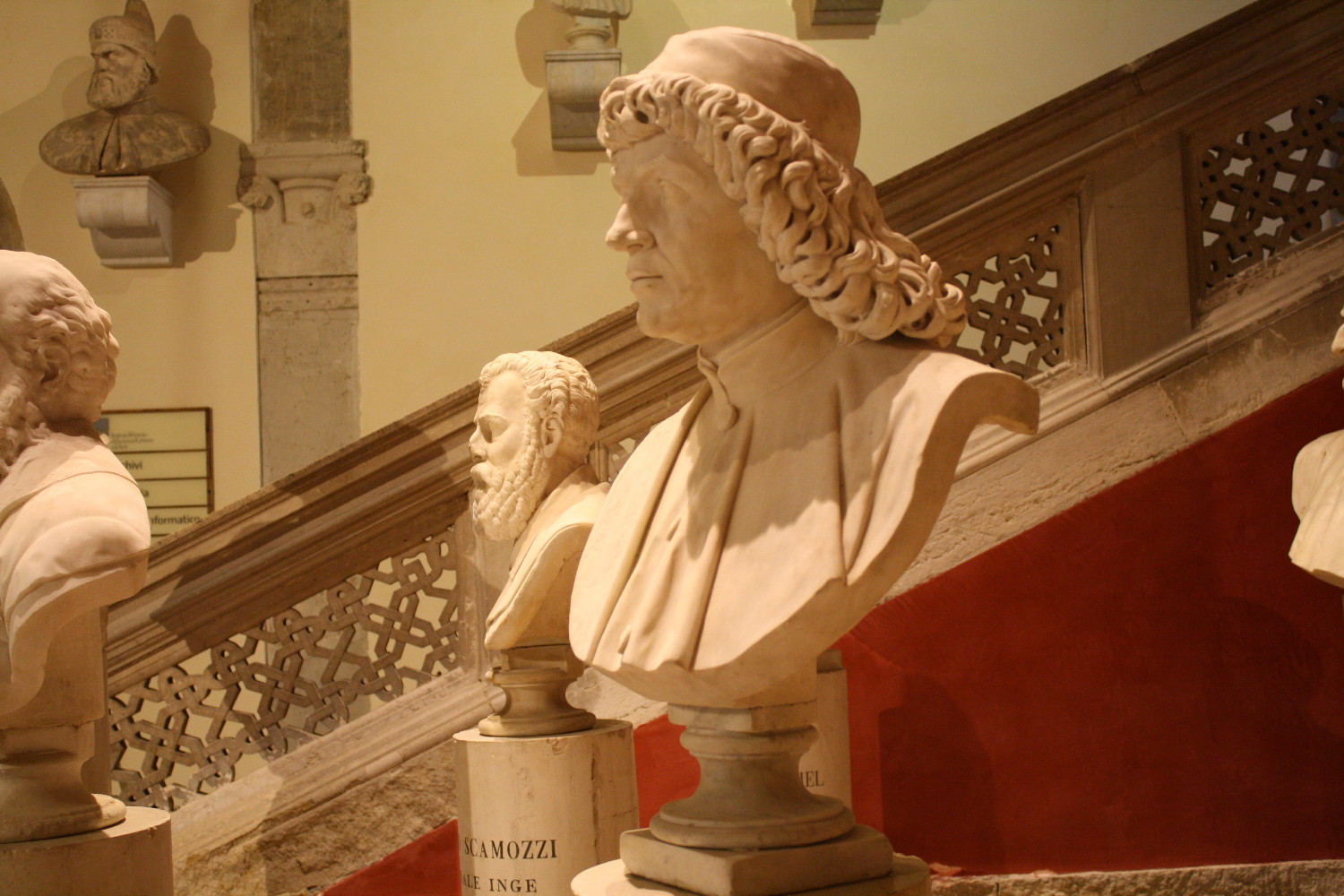 Giovanni Bellini |
 Tiziano and Tintoretto |
 |
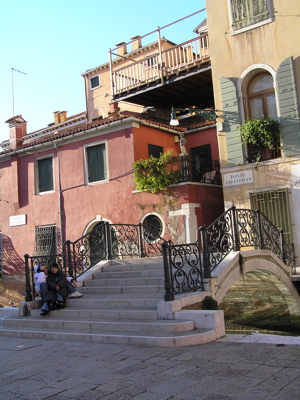 |
 |
| The Doge and the Dogaresa |
P. Giustinian on Rio de S.
Vidal, Cp. S. Vidal |
Rio de
l'Orso and Fondamenta Barbaro |
 |
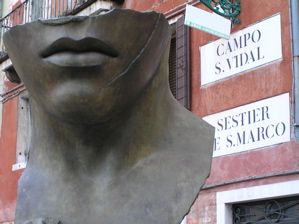 |
|
Campiello Novo o dei Morti with Locanda
Fiorita |
Mitoraj on Campo San Vidal |
| The
endless pedestrian traffic attracts numerous street vendors,
overwhelmingly young males from West
Africa, offering bags and other goods of questionable origin. Some
Venetians call them vu'
comprà, a derogatory term that alludes to the way they
supposedly pronounce the phrase "Vuoi
comprare?"
(Do you want to buy?). When they are not stoically standing by their
merchandise or running from the police, they can be seen in the shadow
of a church, away from the city center, socializing among themselves
and probably dreaming of a better life. During the glorious days of the
Republic, Venetians took pride in being an open and welcoming society
where thousands of immigrants from the four corners of the known world
found a home. Walk all the way to Ponte de l'Accademia, but do not
cross it. You can take a short detour by crossing Rio de San Vidal to
charming Rio del Duca (the next bridge). |
 |
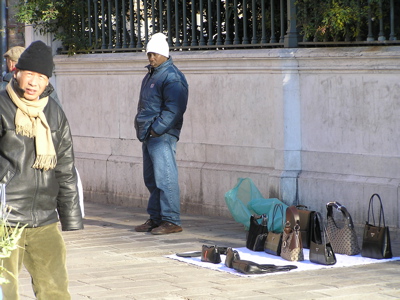 |
| Palazzo
Franchetti-Cavalli-Gussoni, Cp. San Vidal |
Street vendor on Campo
San Vidal |
 |
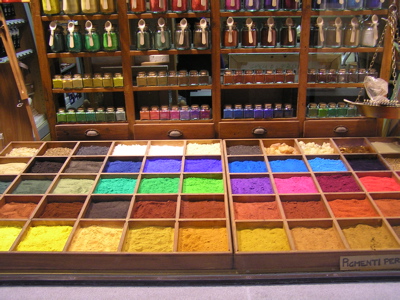 |
 |
| Rio del Duca near Cp. S. Stefano | A
painter's paradise on Calle de le Boteghe |
Fairy-tale houses on
Campo Pisani |
After
you have visited the different corners in and around Campo Santo
Stefano, exit
the campo by the side street at the corner of Gelateria Paolin, Calle de le
Boteghe. Soon on your right you'll see Trattoria
da Fiore, a great place for seafood cicheti and wine. Continue on,
until the street becomes Calle Corner o del Magazen, right after
Salizada San Samuele. At the end of Calle Corner you will find a true
hidden corner of Venice, Corte Corner.
The small garden, the tall trees and the staircase create a magical
space. The vera da pozzo in
the middle of the garden dates from the first half of 12th century and
is Romanesque-Byzantine in style. Animals, leaves and flowers are
carved between the arches. The other wellhead dates from the 14-15th
century. 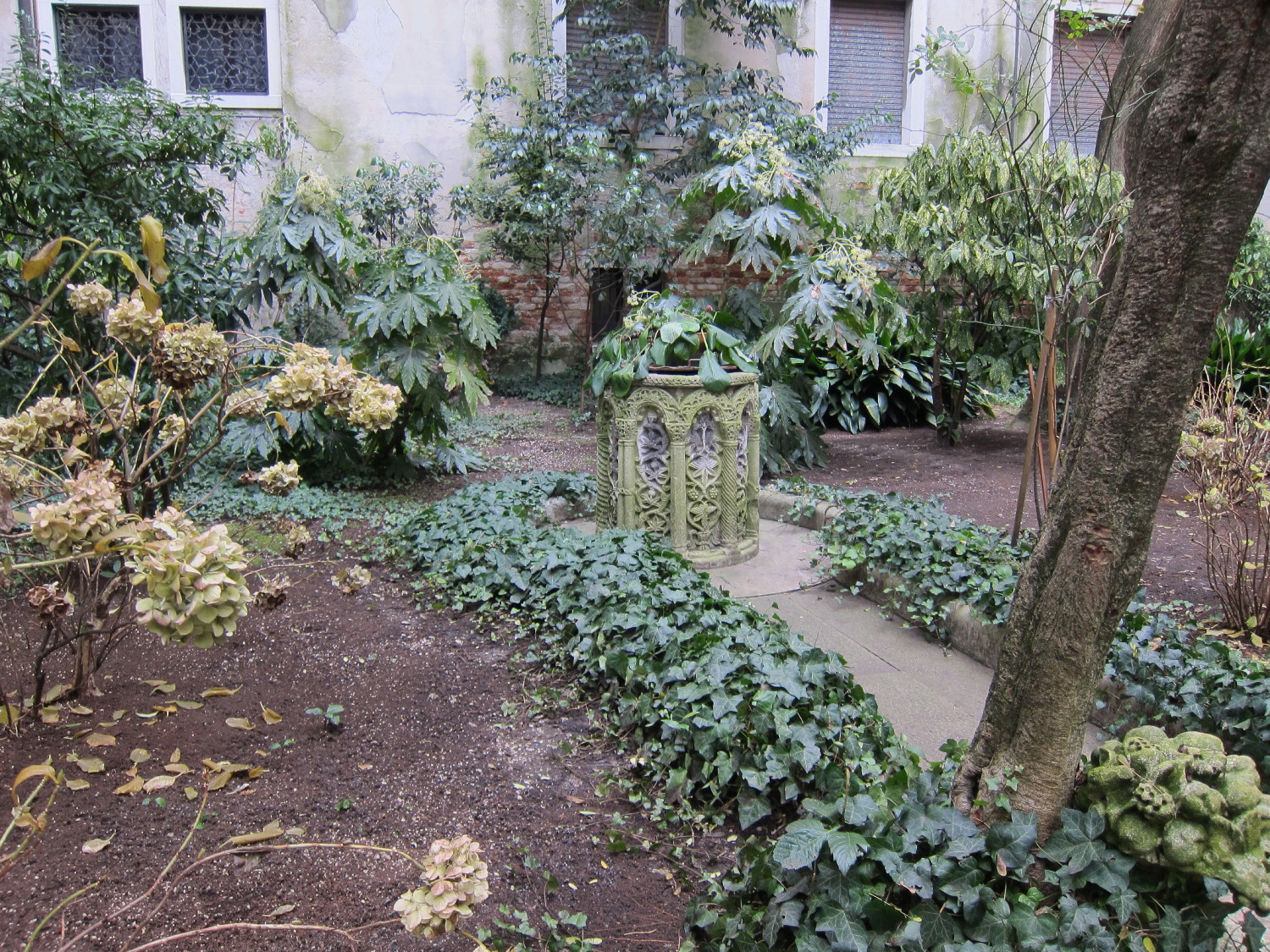  Go back to Salizada San Samuele and turn right. There are some interesting shops in this area selling local and original handicrafts. Soon the street opens into a fork; take either side of the fork; both will take you to the Grand Canal, the church of San Samuele and Palazzo Grassi, where there is always an interesting exhibition going on. 
 Retrace your steps and keep going straight until you reach Piscina San Samuele where you turn right. At the end of the street climb the steps on your left and you will be on Campiello Novo o dei Morti. Cut across the campiello and you will be at the end of Campo Santo Stefano once again, this time by the front door of the church, where you can see a stone tablet dated 1633 prohibiting the opening of shops, cursing, and committing other indecencies near the church.  Cross the bridge at the end of the street, Calle dei Frati (Street of the Friars) and you will be in Campo Sant'Angelo, so called because of the church consecrated to Archangel Michael and demolished in 1837. A plaque in the middle of the campo marks the spot where the church once stood.   On Ponte dei Frati itself is the entrance to the former monastery of Santo Stefano, now a public building. Above the door you can admire a beautiful lunette depicting Saint Augustine protecting a group of monks under his cloak, à la Madonna della Misericordia, a work attributed to Giovanni Buora (end 15th century.) You can visit the cloisters during business hours. The old cloister dates from the 14th century and the newer one from the 16-17th centuries. Its walls used to be adorned with frescoes by Pordenone, now on display at Ca' d'Oro. |
 |
 |
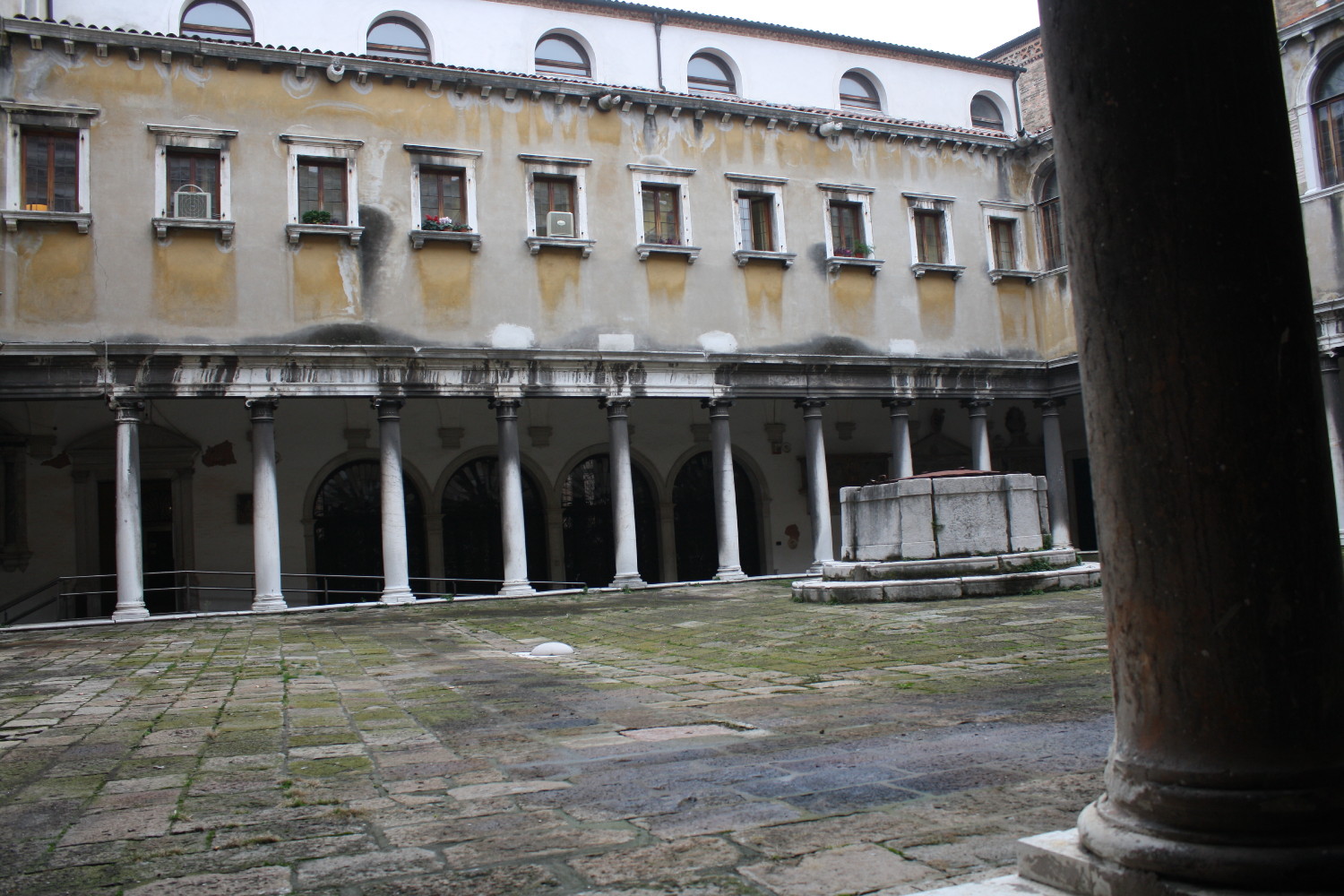 |
 |
| Exit Campo Sant'Angelo by the opposite end, Calle del Spezier which soon becomes Calle de la Mandola (Street of the Almond) and then Calle de la Cortesia (Street of the Courtesy). In typical Venetian fashion all these name changes take place in a short stretch before you reach the next bridge (it should be pointed out, however, that to most Venetians the whole street is commonly known as Calle de la Mandola.) This very quaint area of Venice, enclosed between Campo Sant'Angelo and Campo Manin, offers some quintessential Venetian shops. |
 Rio Terà de la Mandola, off Calle de la Mandola |
 Calle de la Cortesia |
On
Rio Terà dei Assassini (an evocative name that doesn't need
translation), adjacent to Calle de la Mandola is Libreria
Bertoni, a bookstore
that specializes in used and rare books with a large inventory of art
books about Venice. From Calle de la Mandola we are going to take two
detours. The first one on Rio Terà de la Mandola. Before the end
of the street is the secluded Corte Barbarigo with a beautiful vera da pozzo from the second half
of the 15th century.   Make a right turn at the end of
the street (under the sotoportego) and then a left turn and you will be
on Campo San Beneto. Museo Fortuny is located
in Palazzo Pesaro degli Orfei. Fortuny's original work studio, plus
his unique fabrics and inventions, can be viewed here. We exit the
campo from Salizada de la Chiesa o del Teatro and make a left turn on
Calle Sant'Andrea. At the end of this calle
is a beautiful and secluded corte with
an exuberant vera da pozzo,
and a plaque of Sant'Andrea from 1356.The monks of
Sant'Andrea de la Certosa (near the Lido) had a house on this court,
which they used during their visits to the city. Aldo Manuzio, junior,
lived on this court in the 1580s.
  |
 |
We
return to Calle de la Mandola by way of Salizada del Teatro and take
another detour to visit Teatro La Fenice. We
make a right turn on Calle de la Mandola and after a short stretch a
left turn on Calle de la Verona. We cross the wrought-iron
bridge of the same name with a nice view of Rio de la Verona and the
back side of Palazzo Contarini del Bovolo that we'll see later. The
beautiful face carving is on a house nearby. |
| The
first opera house, Teatro Tron,
opened in Venice in 1637. Until then, opera had been a royal
entertainment only performed in the grand halls of the palazzi. One of the most famous
opera houses in the world is La
Fenice, which opened in Venice in 1792 and was destroyed by fire
on two occasions, in 1836 and 1996, and twice rebuilt. The world
premieres of Verdi's operas La
Traviata and Rigoletto
took place at La Fenice. |
 |
 |
| La
Fenice during
reconstruction in 2001 |
The beautiful marquee in 2004 |
 |
The rebuilt theater opened its doors on December 13th, 2003, with a concert of Beethoven, Wagner and Stravinsky, but the first opera production was La Traviata on November 12th, 2004. The theater was painstakingly rebuilt following the Venetian motto "dov'era, com'era" (where it was, how it was) first used for the reconstruction of the San Marco campanile, which collapsed in 1902 and was rebuilt in 1912. |
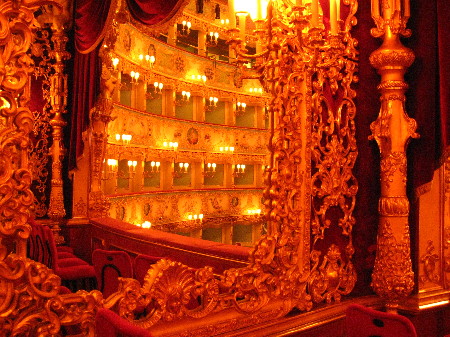 |
| The
area around La Fenice still
carries a bit of a faded bohemian aura in its atmospheric cafes, hotels
and wine bars (bàcari).
A stroll around the many campi
and campielli that surround
the theater, especially right before a performance when people
impeccably dressed flock
from all different corners, will show you another face
of Venice. |
 |
 |
 |
| Ramo
Ferretta with the hotel La Fenice et des Artistes
behind |
Ponte
Storto from Campiello dei Calegheri |
Window on Rio de la
Verona |
We
return to Calle de la Mandola the same way we came in, via Calle de la
Verona, and continue on to Calle de la Cortesia. To the right, before
we
reach the bridge is a wonderful bookstore with a knowledgeable and
friendly staff that specializes in antique Venetian books, Linea
d'Acqua. We cross Ponte de la
Cortesia into Campo Daniele Manin, named after the Venetian patriot who
fought the Austrian rulers in 1848 and was temporarily President of the
the short-lived Republic of San Marco. He lived
in the house between the two bridges.  |
 Ponte de la Cortesia |
 |
 Monument to Daniele Manin |
| |
Gondole
by Campo Manin |
|
Right
in front of us is one of the
most - unjustly, if I may add- vilified buildings in Venice, the Cassa di Risparmio di Venezia, a
savings bank, designed by Luigi Nervi and Angelo Scattolin and built in
the 1970s. I believe history will be kind to this building that is
able to capture the Venetian spirit without losing its 20th-century
soul. This is the location where Aldo
Manuzio, founder of the famous Aldine Press, had his shop in the 15th
and 16th centuries.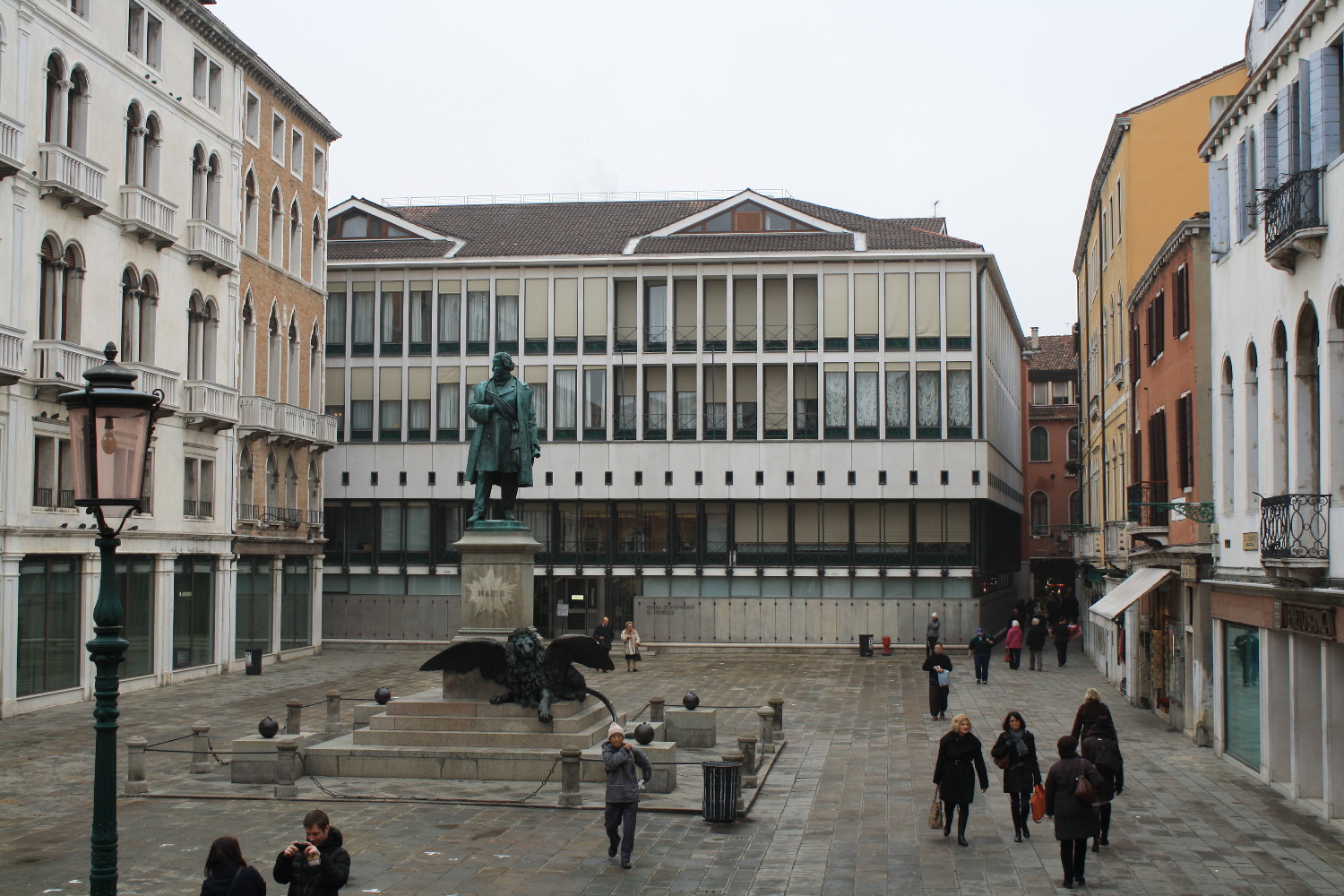  |
| From
Campo Manin we take a detour to the right into narrow Calle de la Vida
(Street of the Grapevine) which soon turns left. After a few steps we
turn right into Calle e Corte Contarini del Bovolo. To your right you
can admire the beautiful spiral staircase. Bovolo means snail in the
Venetian dialect. This remarkable staircase is attributed to Giovanni
Candi, commissioned by Pietro Contarini at the end of the 15th century
to
embellish his Gothic palace. The stairs wind around a central column
with a decreasing pitch as they rise. The view from the top is
breathtaking. |
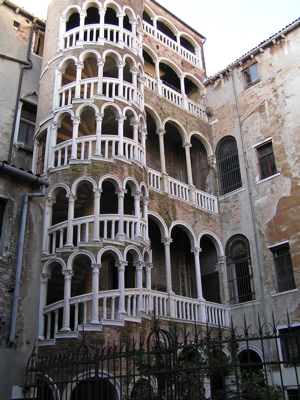 |
 |
 |
We
return to Campo Manin the way we came in and exit the campo by the left
side of the Cassa di Risparmio. We
follow the perimeter of the bank making a right turn on Salizada
San Luca. Libreria Fantoni is
in a corner; it specializes in books on art, architecture, photography
and Venetian themes. We continue onto Campo San Luca, the geographic
center of Venice. Caffè Torino
is in one of the corners. A great place to have a short break and
people watch. We exit the campo by making a left turn on Calle del Forno to the next intersection, Calle del Teatro, where we turn right. Teatro Goldoni will be on your left. We cross the bridge, Ponte del Lovo (Bridge of the Wolf). This is the only bridge in the middle of the city (other than the bridges on Riva degli Schiavoni) from where you can see the campanile di San Marco. |
We
soon reach Campo San Salvador. On your right is the church of San
Salvador. The church houses many artistic treasures such as an Annunciation by Tiziano and the
famous Pala d'Argento Dorato, on
display in the main altar only at certain times of the year (between
December 25 and January 1, from Easter Sunday to the following Sunday
and from August 6 to August 13). The Pala probably dates from the
16th century and its central theme is the Transfiguration of Christ.
During the rest of the year it's hidden by Tiziano's painting also
depicting the Transfiguration of
Christ.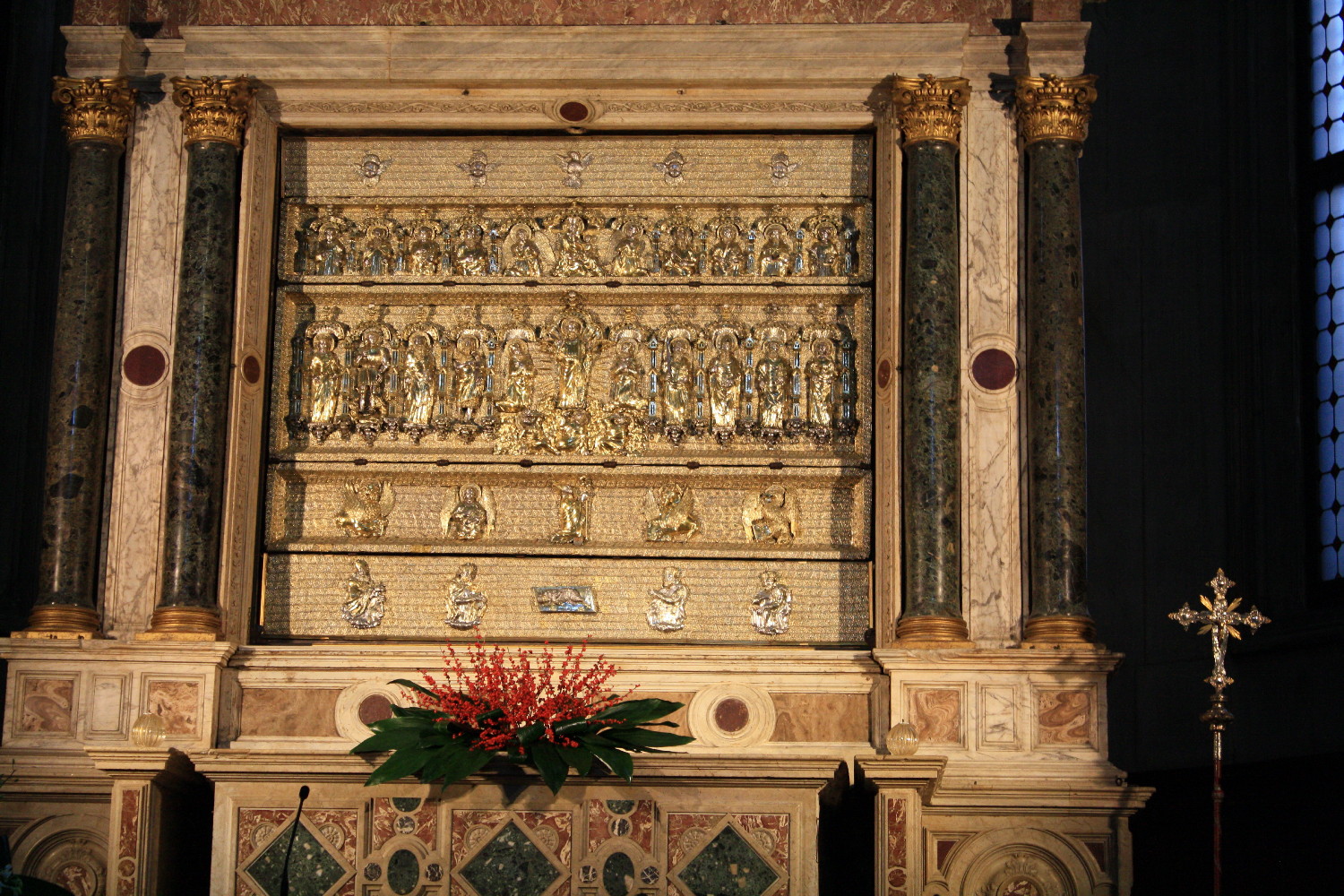 Next to the church, the cloisters
of San Salvador are open to the public. The beautiful Renaissance loggia is attributed to Sansovino
and worth the visit.
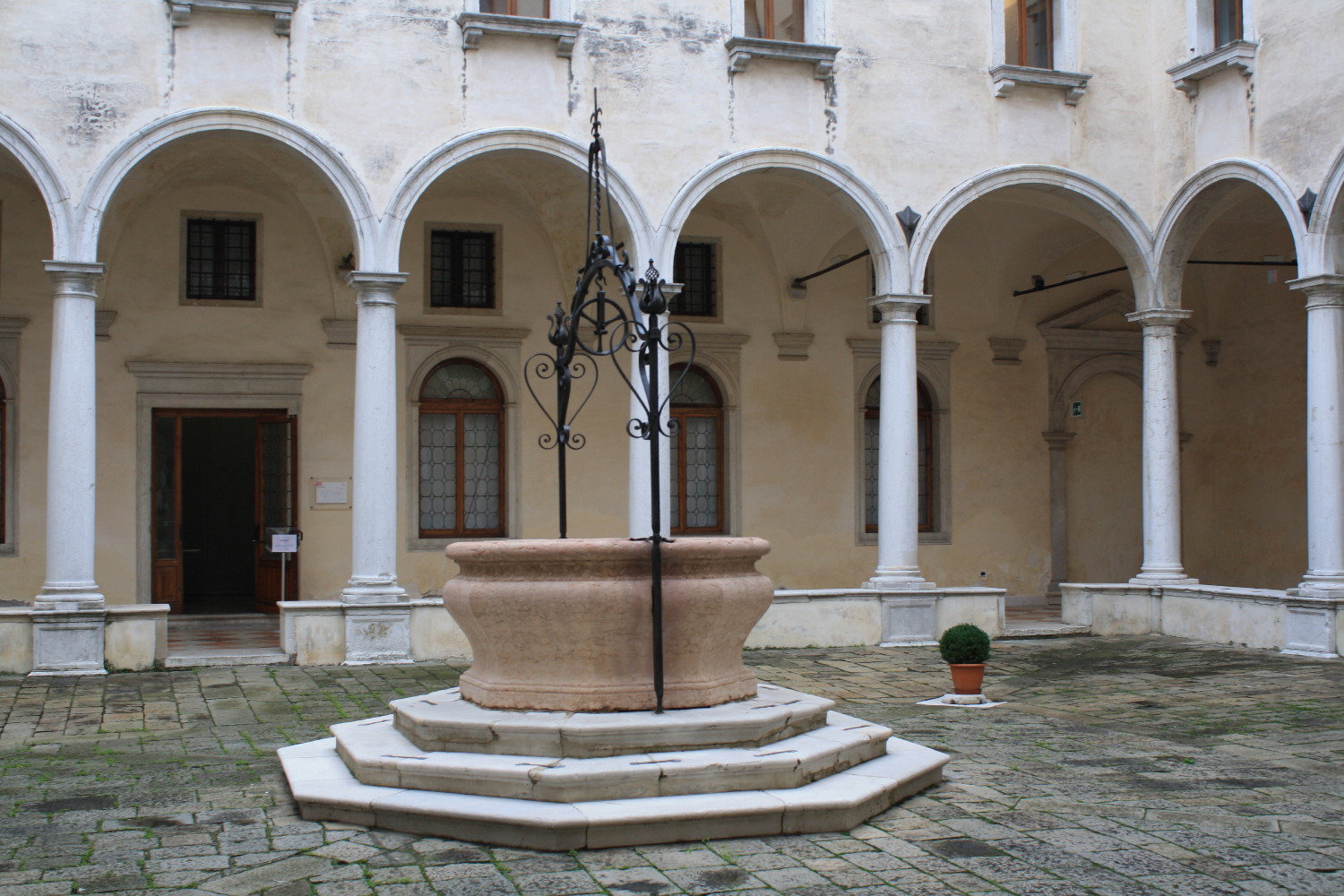 |
| As
we cross Campo San Salvador
and come into Campo San Bartolomeo, a commercial hub, to your left is
the Rialto bridge, to your right the Merceria
or Marzaria, the
shopping district of Venice, and straight ahead Ponte de l'Olio that
connects the sestieri of San
Marco and Cannaregio. In the middle of the campo is the smiling statue
of Carlo Goldoni, Venice's most famous playwright. Before the steps of
the Rialto bridge, to your
right, if you lift your eyes you will see a golden head that used to be
the emblem of an old apothecary, Alla
Testa d'Oro, that specialized in triaca or teriaca a cure-all preparation
with many ingredients that the Venetians cleverly marketed. |
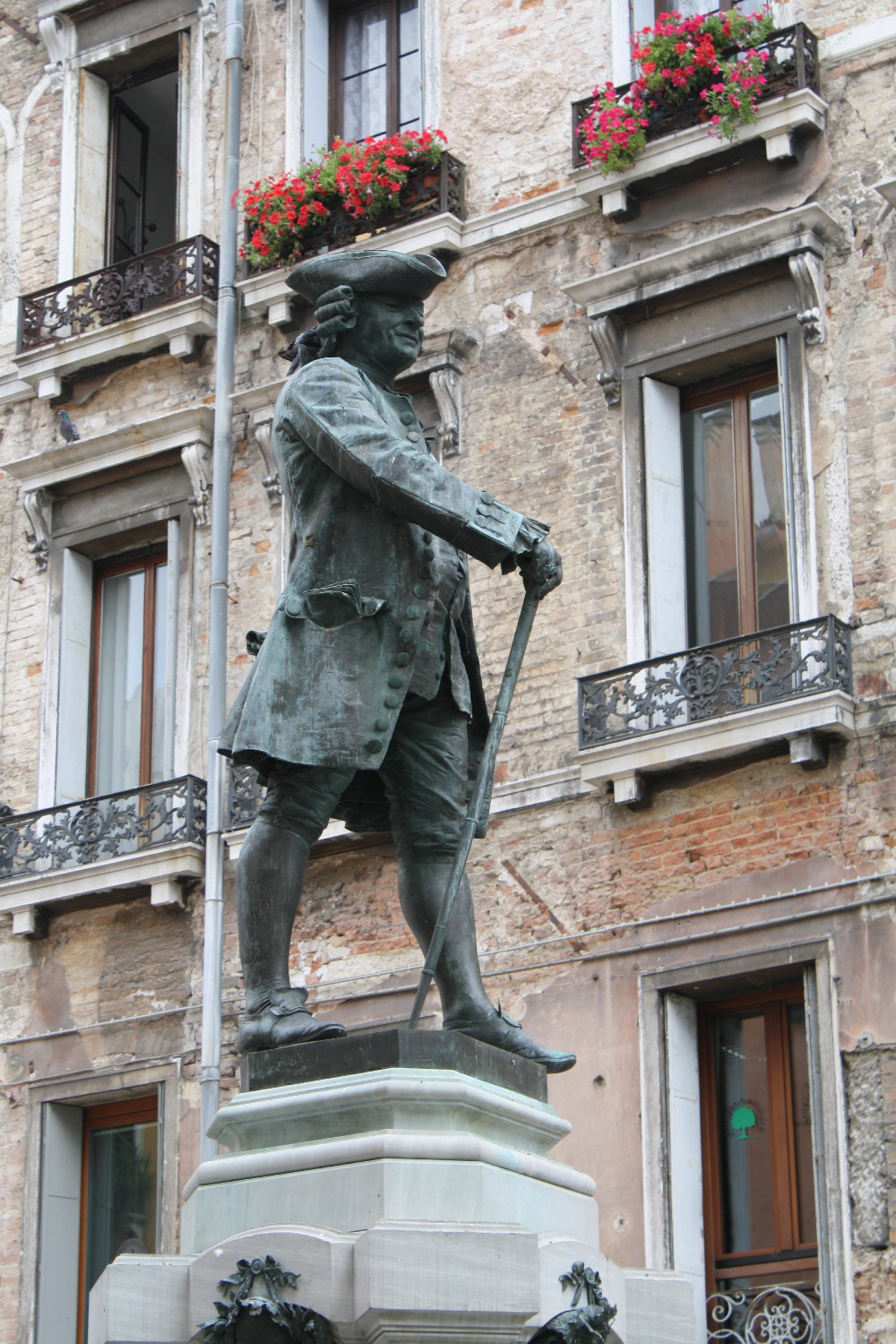 |
 Campo San Bartolomeo
|
|
Goldoni at Campo San Bartolomeo |
|
 |
 |
 |
| The
Rialto Bridge shopping area |
Whimsical
umbrellas at the beginning of the Merceria |
 |
If you reach Ponte de l'Olio,
you will be standing in a unique
spot. It is the only point in the city from where you can see four sestieri all at once.
If you stand in the middle of the bridge with your back to Campo San
Bartolomeo, to your left is San Polo, to your right Castello, ahead of
you Cannaregio, and behind you San Marco. Turn around and you will see
the last number of the sestiere
of San Marco and the end of the
tour.
 |